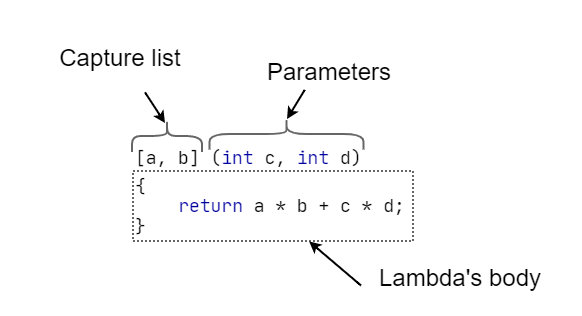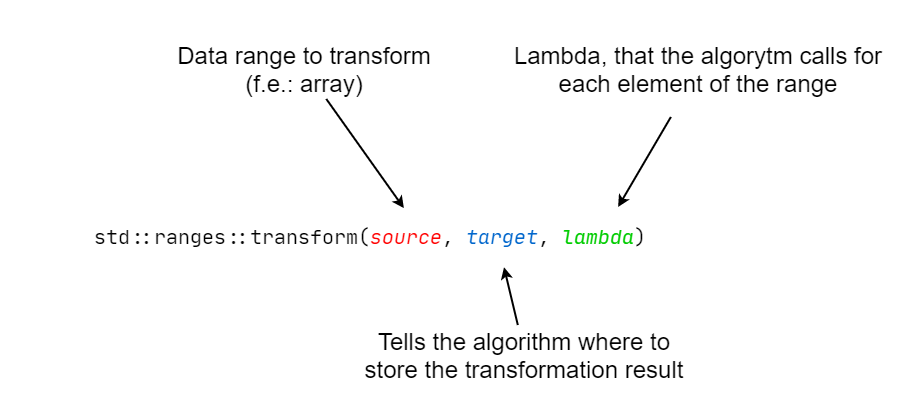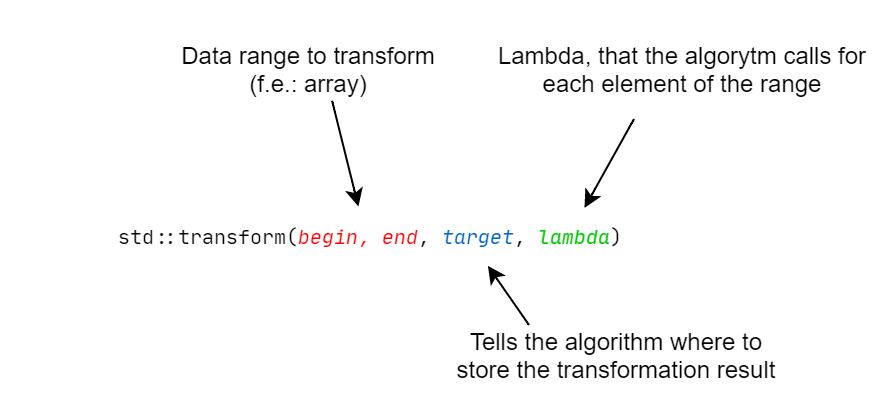Lambda expressions
Lambda expression, more often just called "lambdas", are a convenient way to write a snippet of code in a form of an object, so that it can be sent as a function argument and reused later. Lambdas are mostly used for:
- creating named objects inside functions, that can be later reused just like functions, without polutting the global namespace.
- creating "anonymous" snippets of code that can be sent to other functions (e.g. standard library algorithms).
We recommend to look at Simple examples and Practical usage for some examples.
Lambdas are often called anonymous functions, functors or function objects.
None of these names are correct, although can be used when talking about lambdas.
Indeed, lambdas create an invisible object, although they are only expressions themselves.
Because of the way lambdas work (creating a magic, invisible object, of some magic, not-known type), to assign them to an object,
we need to use the keyword auto, or make use of the standard library type - std::function (we will learn about it further in the course).
The syntax

A lambda must have a body, in which we will write our code and a capture list (that can be empty). The parameter list is optional, although very often used. We can add various other things to the lambda expression, like attributes, explicit return type, etc., although they are neither mandatory nor often used, so we will talk about them further in the course.
Capture list
As we know from the lesson about functions, local variables (e.g. from the main function) are not known in the body of any other function.
The same thing applies to the lambda expressions. Local variables from a function are not visible inside a lambda expression,
that's why they need to be captured in the capture list.
int five = 5;
auto get7 = [five] () { return five + 2; };
std::cout << get7();
7
In case of a lambda expression with an empty parameter list, the parentheses can be ommited.
int five = 5;
auto get7 = [five] { return five + 2; };
std::cout << get7();
The variables captured in the capture list cannot be changed for now. There's a way to do that, but we will talk about it in the second course lesson.
Parameter list
The parameter list in the lambda expression works just like the one we know from functions. It allows us to declare with what parameters our lambda should be called, and then pass arguments to it.
auto multplyBy7 = [] (int a) { return a * 7; }; // a lambda with a parameter of type int
std::cout << multplyBy7(5); // the lambda called with an argument 5
35
The lambda body�
Just a conventional code block, that we already know. Here we declare variables, make operations on objects, etc.
We can use the return statement inside the lambda body.
Simple examples
A comparision of a lambda and a function returning 5 with every call
#include <iostream>
int main()
{
auto five = [] { return 5; };
std::cout << five();
}
#include <iostream>
int five()
{
return 5;
}
int main()
{
std::cout << five();
}
A lambda returning the square of its argument
auto square = [](int x) { return x*x; };
std::cout << square(5);
25
Lambda used for code reusage
void print3Hellos(std::string name) {
auto print_hello = [name](std::string hello) {
std::cout << hello << ", " << name << "!\n";
}
print_hello("Hello");
print_hello("Welcome");
print_hello("Hi");
}
// ...
print3Hellos("Mark");
Hello, Mark!
Welcome, Mark!
Hi, Mark!
Common mistakes
Trying to use a non-captured variable
int main()
{
int A = 5;
// ❌ Variable A is not known inside addToA ❌
// auto addToA = [] (int b) { return A + b; };
// ✅ Proper lambda declaration ✅
auto addToA = [A] (int b) { return A + b; };
std::cout << addToA(5) << "\n";
}
Trying to modify a captured variable
int main()
{
int A = 5;
// ❌ We can't modify the variable A ❌
// auto addToA = [A] (int b) { A += b; };
// ✅ For now, we can make use of the fact that we can return values.
// You will learn how to modify captured variables later in the course. ✅
auto addToA = [A] (int b) { return A + b; };
std::cout << addToA(5) << "\n";
}
Practical usage
We suggest to use the newest C++ version (properly called a standard) - C++20, because it provides a lot of convenient features. If you can't use C++20 for some reason, we also provide examples that work on older versions.
Using a lambda with the transform algorithm
To use this algorithm, you have to include the algorithm header.
#include <algorithm>
The goal
In the example, we will create a vector of numbers and square every each of it with the use of the transform algorithm.
The way to go
The transform algorithm, can be passed a function, function object, or a lambda.
Since it's a lesson about lambdas, we will make use of them. Our lambda will take one parameter of type int and will return a value of the same type.
- C++20
- until C++20

ranges namespaceSince C++20, we can use the more convenient version of the algorithm that's located in the ranges namespace, that's why we have to write std::ranges::transform, instead of std::transform.
1. The source
The first argument is the source of the data - in our case it's a vector of ints.
std::vector<int> data = {1, 2, 3, 4, 5};
std::ranges::transform(data, [...]);
2. The destination
The second argument is the beginning to a container that we want to save the data to.
The other container has to have the same or bigger size, as the source container.
We can use the iterator from our data vector, or from some other one.
std::vector<int> result;
result.resize(data.size());
std::ranges::transform(data, result.begin(), [...]);
// Also correct ✅
std::ranges::transform(data, data.begin(), [...]);
3. The lambda
The most important part of the algorithm, the third argument. We send a lambda that:
- Takes one parameter of the same type as the source container (
intin this case) - Returns a value of the same type as the destination container (also
intin this case)
auto square = [](int a) { return a * a; };
std::ranges::transform(data, result.begin(), square);
// We can also pass the lambda directly, without first saving it into an object:
std::ranges::transform(data, result.begin(), [](int a) { return a * a; });
4. The whole example
#include <iostream>
#include <vector>
#include <algorithm>
int main()
{
std::vector<int> data = {1, 2, 3, 4, 5};
std::cout << "Before using the algorithm:\n";
for(auto elem : data)
{
std::cout << elem << " ";
}
std::cout << "\n\n";
auto square = [](int a) { return a * a; };
std::ranges::transform(data, data.begin(), square);
std::cout << "After using the algorithm:\n";
for(auto elem : data)
{
std::cout << elem << " ";
}
}
Before using the algorithm:
1 2 3 4 5
After using the algorithm:
1 4 9 16 25

1. The source beginning
The first argument is the beginning of the source of data - in our case it's a vector of ints.
std::vector<int> data = {1, 2, 3, 4, 5};
std::transform(data.begin(), [...]);
2. The source end
The second argument is the end of the source of data.
std::transform(data.begin(), data.end(), [...]);
3. The destination
The third argument is the beginning to a container that we want to save the data to.
The other container has to have the same or bigger size, as the source container.
We can use the iterator from our data vector, or from some other one.
std::vector<int> result;
result.resize(data.size());
std::transform(data.begin(), data.end(), result.begin(), [...]);
// Also correct ✅
std::transform(data.begin(), data.end(), data.begin(), [...]);
4. Lambda
The most important part of the algorithm, the fourth argument. We send a lambda that:
- Takes one parameter of the same type as the source container (
intin this case) - Returns a value of the same type as the destination container (also
intin this case)
auto square = [](int a) { return a * a; };
std::transform(data.begin(), data.end(), result.begin(), square);
// We can also pass the lambda directly, without first saving it into an object:
std::transform(data.begin(), data.end() result.begin(), [](int a) { return a * a; });
5. The whole example
#include <iostream>
#include <vector>
#include <algorithm>
int main()
{
std::vector<int> data = {1, 2, 3, 4, 5};
std::cout << "Before using the algorithm:\n";
for(auto elem : data)
{
std::cout << elem << " ";
}
std::cout << "\n\n";
auto square = [](int a) { return a * a; };
std::transform(data.begin(), data.end(), data.begin(), square);
std::cout << "After using the algorithm:\n";
for(auto elem : data)
{
std::cout << elem << " ";
}
}
Before using the algorithm:
1 2 3 4 5
After using the algorithm:
1 4 9 16 25
We will learn more algorithms in the second lesson.